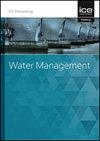The effectiveness of cyclic irrigation (by normal and drainage water) in yield, yield components, and water productivity of maize, soybean, and sunflower
IF 1.1
4区 工程技术
Q3 ENGINEERING, CIVIL
Proceedings of the Institution of Civil Engineers-Water Management
Pub Date : 2022-07-06
DOI:10.1680/jwama.21.00059
引用次数: 0
Abstract
This study evaluated the efficiency of normal and drainage water for cyclic irrigation at a research farm at Shahid Chamran University of Ahvaz from 2019 to 2020. To this end, a 24×30 m farm (was selected and divided into 3 plots (A, B, and C). Corn, soybean, and sunflower were cultivated in plots A, B, and C, respectively, and drainage water was used for irrigation of the next plots (B and C). In plot B, a split-plot design was applied with randomized complete blocks with two treatments: irrigation type (Karun River water and drainage water) and urea fertilizer (100%, 75%, and 50% application) (with three replicates). The experiment design in plot C was similar to that of plot B except for 75% urea fertilizer. ANOVA results for soybean revealed that the interaction between irrigation type and urea levels had significant effects on growth yield and biological water productivity (P<0.01) and fresh leaf weight (P<0.05). ANOVA results for sunflower showed that the interaction between irrigation type and urea levels had significant effects on 100-seed weight, seed yield, and seed water productivity (P<0.05). The highest increase in productivity of the cyclic irrigation system for plot C was related to forage water productivity which increased from 0.768 to 2.603 kg.m−3. The water productivity of Karun River water in the total forage yield, total seed, and total biological yield for the cyclic irrigation system compared to conventional irrigation increased by 76.67%, 72.95%, and 75.45%, respectively. The lowest increase in water productivity from 0.276 to 0.821 (kg.m−3) was related to sunflower seed yield which was 2.97 times higher than conventional irrigation in the cyclic irrigation system. Overall, the data showed that compared to normal irrigation, cyclic irrigation with drainage water saved water and increased water productivity by 45.59% and 100%, respectively.循环灌溉(正常水和排水)对玉米、大豆和向日葵产量、产量构成和水分生产力的影响
本研究评估了2019年至2020年在阿瓦士沙希德查姆兰大学的一个研究农场进行循环灌溉的正常水和排水的效率。为此,选择一个24×30 m农场,将其分为3个地块(a、B、C),分别在a、B、C地块种植玉米、大豆和向日葵,下一个地块(B、C)用排水灌溉。在B地块,采用分地块设计,随机完整块,采用灌溉方式(卡伦河水和排水)和尿素(100%、75%、50%施用量)两种处理(3个重复)。除75%尿素施肥量外,C区试验设计与B区基本相同。单因素方差分析结果显示,灌溉方式和尿素水平对大豆生长产量、生物水分生产力和鲜叶重有极显著的交互作用(P<0.01)。方差分析结果显示,灌溉方式和尿素水平对向日葵百粒重、籽粒产量和籽粒水分生产力有显著的交互作用(P<0.05)。循环灌溉系统对C地块生产力的提高最高,与饲料水分生产力有关,从0.768 kg.m−3提高到2.603 kg.m−3。与常规灌溉相比,循环灌溉系统的卡伦河水在总饲料产量、总种子产量和总生物产量中的水分生产力分别提高了76.67%、72.95%和75.45%。在循环水灌溉系统中,葵花籽产量增幅最小,从0.276增加到0.821 (kg.m−3),是常规灌溉的2.97倍。总体而言,数据显示,与正常灌溉相比,循环水灌溉节水和提高水分生产力分别为45.59%和100%。
本文章由计算机程序翻译,如有差异,请以英文原文为准。
求助全文
约1分钟内获得全文
求助全文
来源期刊
CiteScore
2.10
自引率
0.00%
发文量
28
审稿时长
6-12 weeks
期刊介绍:
Water Management publishes papers on all aspects of water treatment, water supply, river, wetland and catchment management, inland waterways and urban regeneration.
Topics covered: applied fluid dynamics and water (including supply, treatment and sewerage) and river engineering; together with the increasingly important fields of wetland and catchment management, groundwater and contaminated land, waterfront development and urban regeneration. The scope also covers hydroinformatics tools, risk and uncertainty methods, as well as environmental, social and economic issues relating to sustainable development.

 求助内容:
求助内容: 应助结果提醒方式:
应助结果提醒方式:


